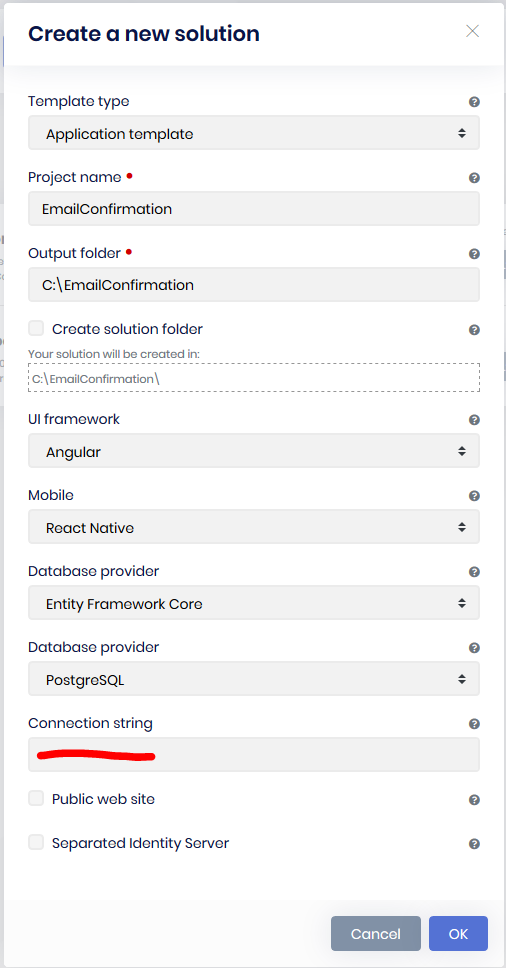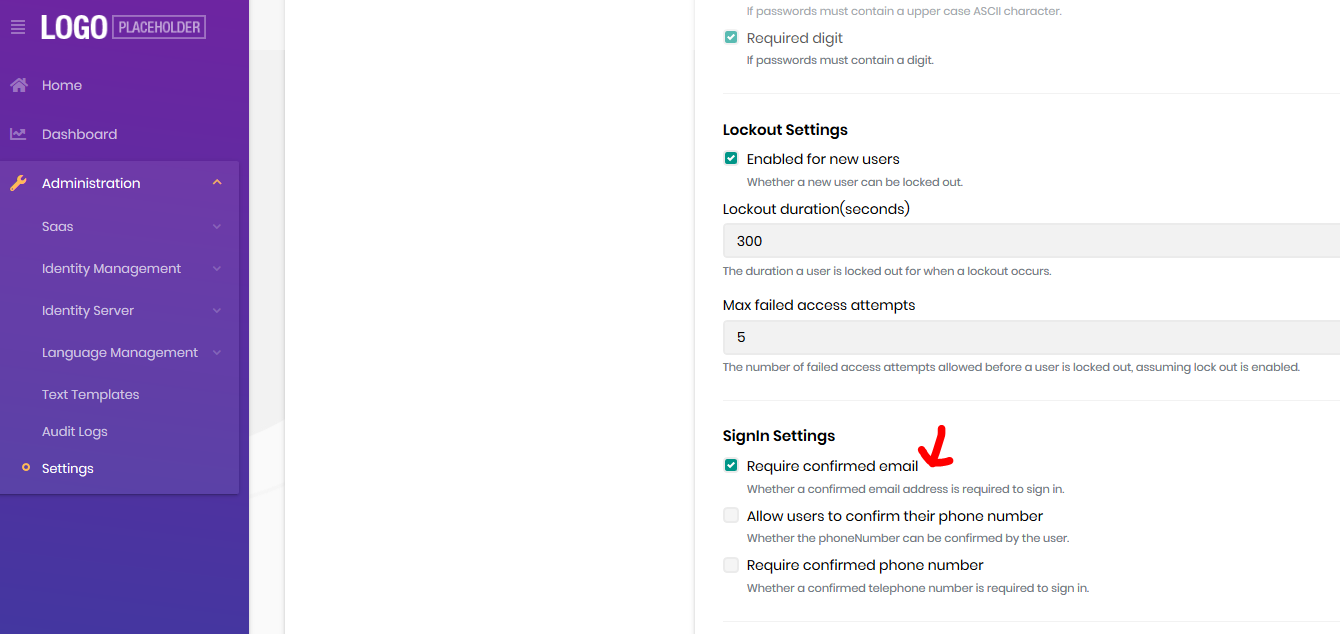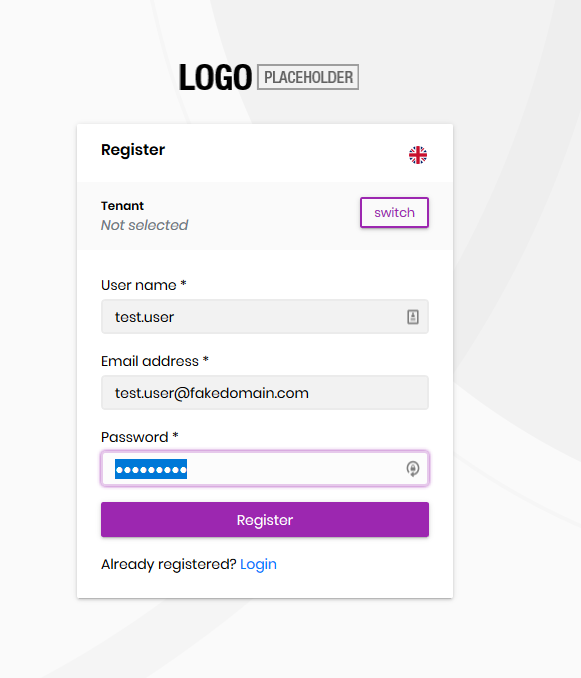Activities of "riley.trevillion"
Check the docs before asking a question: https://docs.abp.io/en/commercial/latest/ Check the samples, to see the basic tasks: https://docs.abp.io/en/commercial/latest/samples/index The exact solution to your question may have been answered before, please use the search on the homepage.
If you're creating a bug/problem report, please include followings:
- ABP Framework version: v5.2.2
- UI type: Angular
- DB provider: EF Core
- Tiered (MVC) or Identity Server Separated (Angular): no
Hello
I have been developing dynamic theming functionality for our application so that tenants can select their own colour schemes, logo and background images at runtime with only minimal Lepton Theme sourcecode integration to achieve it (allowing for easier Abp Framework version upgrades). I've been weighing up whether to write a community article sharing how it can be done (time permitting!). To give a brief summary of how it works -
- Certain Lepton Theme styles / colours have been overriden with CSS var() values to allow changing of colours are runtime (not build time)
- These var() values are set on application startup during the APP_INITIALIZE phase of the Angular client from a custom branding endpoint I have set up on the server side
- The Identity Server login / registration / confirmation etc etc pages utilise the Javascript API functionality to call this endpoint as well to set the var() values for the server side
- The var() values are stored as settings strings (HEX format) using the built in ABP setting management functionality
- The app is multi tenant so that when the tenant is swapped, the branding values specific to the tenant are loaded and applied in realtime
Everything works really well and is close to feature completeness, but there is one issue presenting 'bug-like' behaviour that I would like to resolve before calling it 100% complete.
When a users swaps to a different tenant on an Identity Server page, the new tenants branding is loaded and all the colours update correctly. When you log in and are redirected back to the Angular client, the Angular client will be loaded with the previous tenants branding information instead of the new tenant.
It appears as though the branding information is being retrieved before the tenant cookie is being updated to use the new tenant id on the Angular side. If I refresh the page, the correct branding is loaded as the tenant cookie is now set with the new tenant id.
Is there a way within the APP_INITIALIZE phase to have the tenant cookie update first before my branding loading function is called? I don't know how to define this kind of relationship during app startup.
I have attached screenshots that I hope will clarify the issue
Old tenant id sent to branding endpoint
New tenant id requested after branding request in APP_INITIALIZE
Thankyou
- ABP Framework version: v5.2.0
- UI type: Angular
- DB provider: EF Core
- Tiered (MVC) or Identity Server Separated (Angular): no
Hi
I'm attempting to add a many-to-many relationship between my aggregate root and the built in IdentityUser class using the EF Core Fluent API. I'm am having trouble defining this relationship.
Once the relationship is defined it is my intention to be able to pull a user out of the database and '.Include()' the navigation property defined on the IdentityUser to get a list of ActivityInstances they are part of (and vice versa).
Could you please advise on what I am doing wrong and whether I need to approach this differently to have a many-to-many with IdentityUser or whether this is a bug and that I should be able to reference the navigation property defined via the EntityExtensionMapping in the Fluent API?
ActivityInstance (my aggregate root)
- AssociatedBookings is the navigation property
SchedulerEfCoreEntityExtensionMappings
- This is to add the navigation property to the IdentityUser
- The const string value is "AssociatedInstances"
SchedulerDbContextModelCreatingExtensions
- The configuration block gives me an error (see screenshot) if I attempt to configure the relationship with a string value
- I am unable to select the property defined in the SchedulerEfCoreEntityExtensionMappings file if I attempt to use the typical lambda method of selecting the property instead
My understanding is that EF Core will automatically produce the joining table with the appropriate foreign keys configured. This works as intended with other many-to-many relationships I have defined between my other entities where I have direct control over the navigation properties defined in those classes as shown here

I'm aware that the property definition in the SchedulerEfCoreEntityExtensionMappings file might interfer with how EF Core automatically configures the joining table with the appropriate foreign keys but I'm not sure.
Thankyou
Check the docs before asking a question: https://docs.abp.io/en/commercial/latest/ Check the samples, to see the basic tasks: https://docs.abp.io/en/commercial/latest/samples/index The exact solution to your question may have been answered before, please use the search on the homepage.
If you're creating a bug/problem report, please include followings:
- ABP Framework version: v4.4.3
- UI type: Angular
- DB provider: EF Core
- Tiered (MVC) or Identity Server Separated (Angular): no
- Exception message and stack trace:
- Steps to reproduce the issue:"
<br> Hello I was taking a look at integrating the commercial Forms Module (https://commercial.abp.io/modules/Volo.Forms) into my application but I saw it was only supported in the MVC UI framework and not Angular. <br>
- Is there a roadmap or ETA available as to when the Forms Module will support Angular?
- Could we install the forms module on the server side (which I assume would set up the database tables and services) and build the Angular UI components ourselves to connect to the module endpoints?
- Do you see any problems with this or issues that we may encounter?
- Are there any things we need to consider when building the Angular components that might trip us up?
- Do you know of a better approach or pattern we could use instead if this isn't the right approach?
Thank you
Check the docs before asking a question: https://docs.abp.io/en/commercial/latest/ Check the samples, to see the basic tasks: https://docs.abp.io/en/commercial/latest/samples/index The exact solution to your question may have been answered before, please use the search on the homepage.
If you're creating a bug/problem report, please include followings:
- ABP Framework version: 4.3.3
- UI type: Angular
- DB provider: EF Core
- Tiered (MVC) or Identity Server Separated (Angular): no
- Exception message and stack trace: See below
- Steps to reproduce the issue:" See below
The following can be reproduced in the application I am developing and in the public ABP Commercial Demo you have running on your website (https://commercial-demo.abp.io)
Step One
Set the menu placement to top
 <br>
<br>
Step Two
Resize the page to trigger mobile view. Its not uncommon to shrink windows down to a smaller size when multi tasking
 <br>
<br>
Step Three
Either maximise the window or slow drag the edge to return to the full sized app view. Observe that the layout has reverted to the side panel layout. Moving around the app will not cause the layout to fix itself. It will stay this way only until your leave and come back to the Lepton Theme settings tab where it will suddenly fix itself and return to the top menu placement viiew



- ABP Framework version: 4.3.0
- UI type: Angular
- DB provider: EF Core
- Tiered (MVC) or Identity Server Separated (Angular): No
- Exception message and stack trace: See below
- Steps to reproduce the issue: See below
Please see https://support.abp.io/QA/Questions/1291/Azure-AD-Configuration-and-Login-Issues--Angular for additional context
Steps To Reproduce
- Log in with a local admin user and turn on 'require users to confirm email' setting in ABP
- Log out
- Log in via Azure AD with a user that has never logged in before
- Observe the login process is successful and the user can begin using ABP
- Log out
- Attempt to log in via Azure AD with the same user again
- Observe the 'username taken' error
If you switch the 'require users to confirm email' setting off the issue doesn't occur anymore and an Azure AD user can log in and out multiple times without error. This isn't ideal though as we'd like to have local users with confirmed email addresses as well as Azure AD users.
- ABP Framework version: 4.3.0
- UI type: Angular
- DB provider: EF Core
- Tiered (MVC) or Identity Server Separated (Angular): No
- Exception message and stack trace: See below
- Steps to reproduce the issue: See below
<br> Hello
I'm trying to integrate Azure Active Directory as an external login provider for our application which is using the Angular UI. I have followed the instructions in this article (https://community.abp.io/articles/how-to-setup-azure-active-directory-and-integrate-abp-angular-application-lyk87w5l) but I have encountered a number of issues during the setup that I hope you can assist me in resolving.
I have created a fresh copy of the ABP solution to rule out anything specific with our product and I am still able to reproduce the issues in the fresh solution. Either there is a bug or I am misconfiguring something in the app or in Azure AD.
Steps To Reproduce
- Set 'admin' as the default role in the ABP application so that new users are automatically assigned that role on creation (achieved by loging in with precreated local admin user)
- Register application in Azure AD
- Add the following code blocks to HttpApi.Host > [App Name]HttpApiHostModule.cs to enable OpenID connection
- Log in with the Azure AD user
- Observe that the correct menus for the admin role are present, but the user is not logged in. If you attempt to access any of the menus or application items it will redirect you for authentication briefly and then drop you back at the same page
- Some things worth noting
- I'm aware of the
CORS request made for path: /api/abp/application-configuration from origin:http://localhost:4200but was ignored because path was not for an allowed IdentityServer CORS endpointerror in the provided logs. I have added this origin to the CORS configuration in the database, and it appears to be accessing that origin just fine based on the network logs (see screenshots). I'm not sure whether this is an issue. - I cannot log in with the local admin user anymore once the OpenID code has been placed into the solution. It produces the same 'not logged in' state I've described above. The culprit is appears to related to the claim manipulation code blocks that the guide has directed me to include i.e
JwtSecurityTokenHandler.DefaultInboundClaimTypeMap.Clear(); JwtSecurityTokenHandler.DefaultInboundClaimTypeMap.Add("sub", ClaimTypes.NameIdentifier);I am able to log in with a local user if those code blocks are removed, but if I try and log in with the AzureAD user I just get returned to the login page. I've attached logs of whats going on under the REMOVED JwtSecurityTokenHandler CODE BLOCKS log below.
- I'm aware of the
I've provided as much information as possible to help with diagnosing this issue. It would be good if you are able to confirm the problems I've described on your end with a fresh solution following the reproducability steps I've detailed above. That would help narrow down whether these issues are related to bugs in the solution or if I am misconfiguring something / the article I've followed is no longer accurate for version 4.3.0 and I need to perform additional configuration.
Thank you
REMOVED JwtSecurityTokenHandler CODE BLOCKS LOG:https://perceptualcomputing-my.sharepoint.com/:t:/g/personal/riley_trevillion_perceptualcomputing_com_au/EUYhYWRsvl1LjrARezYmZW4BN9rBajLXdP5-LPsfRTHLZw?e=Fagkr1
- ABP Framework version: v4.2.2 / v4.3-preview
- UI type: Angular
- DB provider: EF Core
- Tiered (MVC) or Identity Server Separated (Angular): No
- Exception message and stack trace:
Hello
I've been looking for a way to expire a users login session after X period of time has passed which automatically redirects them to the Identity Server login page.
As a starting point for this task, I have followed the advice provided on https://support.abp.io/QA/Questions/957/Force-users-to-re-login-if-they-are-inactive-in-30-minutes and set, in the IdentityServerClients DB table, the
- AbsoluteRefreshTokenLifetime value to 30min
- SlidingRefreshTokenLifetime to 15min
- AccessTokenLifetime to 6.5mins
As expected, the access_tokenis renewed using the refresh_token at the correct time and continues to do so up until the 30 min mark when the refresh_token expires. This is all fine and works as expected.

Where I'm having trouble is when the refresh_token expires, instead of the ABP / Angular client redirecting to the Identity Server login screen for re-authentication, the application becomes stuck when refreshing the browser page and is unusable until the user clears all their cookies / cache. A 400 error is given which makes me think the application is trying to use the expired refresh_token to get more access_tokens after the 30 minute mark.
<br>
log.js:24 [HMR] Waiting for update signal from WDS...
ngxs-store.js:1965 RECOMMENDATION: Set developmentMode to true on the NgxsModule when Angular is running in development mode.
angular-oauth2-oidc.js:1551 Error refreshing token HttpErrorResponse {headers: HttpHeaders, status: 400, statusText: "OK", url: "https://localhost:44362/connect/token", ok: false, …}
core.js:5980 ERROR HttpErrorResponse {headers: HttpHeaders, status: 400, statusText: "OK", url: "https://localhost:44362/connect/token", ok: false, …}
main.ts:14 HttpErrorResponse {headers: HttpHeaders, status: 400, statusText: "OK", url: "https://localhost:44362/connect/token", ok: false, …}
(anonymous) @ main.ts:14
invoke @ zone-evergreen.js:364
run @ zone-evergreen.js:123
(anonymous) @ zone-evergreen.js:857
invokeTask @ zone-evergreen.js:399
runTask @ zone-evergreen.js:167
drainMicroTaskQueue @ zone-evergreen.js:569
invokeTask @ zone-evergreen.js:484
invokeTask @ zone-evergreen.js:1621
globalZoneAwareCallback @ zone-evergreen.js:1658
load (async)
customScheduleGlobal @ zone-evergreen.js:1773
scheduleTask @ zone-evergreen.js:385
onScheduleTask @ zone-evergreen.js:272
scheduleTask @ zone-evergreen.js:378
scheduleTask @ zone-evergreen.js:210
scheduleEventTask @ zone-evergreen.js:236
(anonymous) @ zone-evergreen.js:1928
(anonymous) @ http.js:1773
_trySubscribe @ Observable.js:42
subscribe @ Observable.js:28
call @ finalize.js:11
subscribe @ Observable.js:23
innerSubscribe @ innerSubscribe.js:67
_innerSub @ mergeMap.js:57
_tryNext @ mergeMap.js:51
_next @ mergeMap.js:34
next @ Subscriber.js:49
(anonymous) @ subscribeToArray.js:3
_trySubscribe @ Observable.js:42
subscribe @ Observable.js:28
call @ mergeMap.js:19
subscribe @ Observable.js:23
call @ filter.js:13
subscribe @ Observable.js:23
call @ map.js:16
subscribe @ Observable.js:23
call @ switchMap.js:15
subscribe @ Observable.js:23
(anonymous) @ angular-oauth2-oidc.js:1543
ZoneAwarePromise @ zone-evergreen.js:960
refreshToken @ angular-oauth2-oidc.js:1512
(anonymous) @ abp-ng.core.js:2411
invoke @ zone-evergreen.js:364
onInvoke @ core.js:28301
invoke @ zone-evergreen.js:363
run @ zone-evergreen.js:123
(anonymous) @ zone-evergreen.js:857
invokeTask @ zone-evergreen.js:399
onInvokeTask @ core.js:28289
invokeTask @ zone-evergreen.js:398
runTask @ zone-evergreen.js:167
drainMicroTaskQueue @ zone-evergreen.js:569
invokeTask @ zone-evergreen.js:484
invokeTask @ zone-evergreen.js:1621
globalZoneAwareCallback @ zone-evergreen.js:1658
load (async)
customScheduleGlobal @ zone-evergreen.js:1773
scheduleTask @ zone-evergreen.js:385
onScheduleTask @ zone-evergreen.js:272
scheduleTask @ zone-evergreen.js:378
scheduleTask @ zone-evergreen.js:210
scheduleEventTask @ zone-evergreen.js:236
(anonymous) @ zone-evergreen.js:1928
(anonymous) @ http.js:1773
_trySubscribe @ Observable.js:42
subscribe @ Observable.js:28
call @ finalize.js:11
subscribe @ Observable.js:23
innerSubscribe @ innerSubscribe.js:67
_innerSub @ mergeMap.js:57
_tryNext @ mergeMap.js:51
_next @ mergeMap.js:34
next @ Subscriber.js:49
(anonymous) @ subscribeToArray.js:3
_trySubscribe @ Observable.js:42
subscribe @ Observable.js:28
call @ mergeMap.js:19
subscribe @ Observable.js:23
call @ filter.js:13
subscribe @ Observable.js:23
call @ map.js:16
subscribe @ Observable.js:23
(anonymous) @ angular-oauth2-oidc.js:1339
ZoneAwarePromise @ zone-evergreen.js:960
loadJwks @ angular-oauth2-oidc.js:1337
(anonymous) @ angular-oauth2-oidc.js:1313
__tryOrUnsub @ Subscriber.js:183
next @ Subscriber.js:122
_next @ Subscriber.js:72
next @ Subscriber.js:49
_next @ map.js:35
next @ Subscriber.js:49
_next @ filter.js:33
next @ Subscriber.js:49
notifyNext @ mergeMap.js:70
_next @ innerSubscribe.js:10
next @ Subscriber.js:49
_next @ Subscriber.js:72
next @ Subscriber.js:49
onLoad @ http.js:1687
invokeTask @ zone-evergreen.js:399
onInvokeTask @ core.js:28289
invokeTask @ zone-evergreen.js:398
runTask @ zone-evergreen.js:167
invokeTask @ zone-evergreen.js:480
invokeTask @ zone-evergreen.js:1621
globalZoneAwareCallback @ zone-evergreen.js:1658
load (async)
customScheduleGlobal @ zone-evergreen.js:1773
scheduleTask @ zone-evergreen.js:385
onScheduleTask @ zone-evergreen.js:272
scheduleTask @ zone-evergreen.js:378
scheduleTask @ zone-evergreen.js:210
scheduleEventTask @ zone-evergreen.js:236
(anonymous) @ zone-evergreen.js:1928
(anonymous) @ http.js:1773
_trySubscribe @ Observable.js:42
subscribe @ Observable.js:28
call @ finalize.js:11
subscribe @ Observable.js:23
innerSubscribe @ innerSubscribe.js:67
_innerSub @ mergeMap.js:57
_tryNext @ mergeMap.js:51
_next @ mergeMap.js:34
next @ Subscriber.js:49
(anonymous) @ subscribeToArray.js:3
_trySubscribe @ Observable.js:42
subscribe @ Observable.js:28
call @ mergeMap.js:19
subscribe @ Observable.js:23
call @ filter.js:13
subscribe @ Observable.js:23
call @ map.js:16
subscribe @ Observable.js:23
(anonymous) @ angular-oauth2-oidc.js:1291
ZoneAwarePromise @ zone-evergreen.js:960
loadDiscoveryDocument @ angular-oauth2-oidc.js:1279
(anonymous) @ abp-ng.core.js:2391
(anonymous) @ tslib.es6.js:76
ZoneAwarePromise @ zone-evergreen.js:960
__awaiter @ tslib.es6.js:72
init @ abp-ng.core.js:2386
(anonymous) @ abp-ng.core.js:2405
(anonymous) @ tslib.es6.js:76
ZoneAwarePromise @ zone-evergreen.js:960
__awaiter @ tslib.es6.js:72
init @ abp-ng.core.js:2404
(anonymous) @ abp-ng.core.js:2492
(anonymous) @ tslib.es6.js:76
ZoneAwarePromise @ zone-evergreen.js:960
__awaiter @ tslib.es6.js:72
init @ abp-ng.core.js:2491
(anonymous) @ abp-ng.core.js:2654
fulfilled @ tslib.es6.js:73
invoke @ zone-evergreen.js:364
onInvoke @ core.js:28301
invoke @ zone-evergreen.js:363
run @ zone-evergreen.js:123
(anonymous) @ zone-evergreen.js:857
invokeTask @ zone-evergreen.js:399
onInvokeTask @ core.js:28289
invokeTask @ zone-evergreen.js:398
runTask @ zone-evergreen.js:167
drainMicroTaskQueue @ zone-evergreen.js:569
invokeTask @ zone-evergreen.js:484
invokeTask @ zone-evergreen.js:1621
globalZoneAwareCallback @ zone-evergreen.js:1658
load (async)
customScheduleGlobal @ zone-evergreen.js:1773
scheduleTask @ zone-evergreen.js:385
onScheduleTask @ zone-evergreen.js:272
scheduleTask @ zone-evergreen.js:378
scheduleTask @ zone-evergreen.js:210
scheduleEventTask @ zone-evergreen.js:236
(anonymous) @ zone-evergreen.js:1928
(anonymous) @ http.js:1773
_trySubscribe @ Observable.js:42
subscribe @ Observable.js:28
call @ finalize.js:11
subscribe @ Observable.js:23
innerSubscribe @ innerSubscribe.js:67
_innerSub @ mergeMap.js:57
_tryNext @ mergeMap.js:51
_next @ mergeMap.js:34
next @ Subscriber.js:49
(anonymous) @ subscribeToArray.js:3
_trySubscribe @ Observable.js:42
subscribe @ Observable.js:28
call @ mergeMap.js:19
subscribe @ Observable.js:23
call @ filter.js:13
subscribe @ Observable.js:23
call @ map.js:16
subscribe @ Observable.js:23
call @ catchError.js:14
subscribe @ Observable.js:23
call @ tap.js:16
subscribe @ Observable.js:23
(anonymous) @ Observable.js:91
ZoneAwarePromise @ zone-evergreen.js:960
toPromise @ Observable.js:89
getRemoteEnv @ abp-ng.core.js:2521
(anonymous) @ abp-ng.core.js:2652
(anonymous) @ tslib.es6.js:76
ZoneAwarePromise @ zone-evergreen.js:960
__awaiter @ tslib.es6.js:72
fn @ abp-ng.core.js:2646
runInitializers @ core.js:27596
(anonymous) @ core.js:28911
_callAndReportToErrorHandler @ core.js:29012
(anonymous) @ core.js:28909
invoke @ zone-evergreen.js:364
onInvoke @ core.js:28301
invoke @ zone-evergreen.js:363
run @ zone-evergreen.js:123
run @ core.js:28184
bootstrapModuleFactory @ core.js:28891
(anonymous) @ core.js:28943
invoke @ zone-evergreen.js:364
run @ zone-evergreen.js:123
(anonymous) @ zone-evergreen.js:857
invokeTask @ zone-evergreen.js:399
runTask @ zone-evergreen.js:167
drainMicroTaskQueue @ zone-evergreen.js:569
Promise.then (async)
scheduleMicroTask @ zone-evergreen.js:552
scheduleTask @ zone-evergreen.js:388
scheduleTask @ zone-evergreen.js:210
scheduleMicroTask @ zone-evergreen.js:230
scheduleResolveOrReject @ zone-evergreen.js:847
then @ zone-evergreen.js:979
bootstrapModule @ core.js:28943
(anonymous) @ main.ts:13
zUnb @ main.ts:14
__webpack_require__ @ bootstrap:853
fn @ bootstrap:150
9 @ main.js:2507
__webpack_require__ @ bootstrap:853
checkDeferredModules @ bootstrap:45
webpackJsonpCallback @ bootstrap:32
(anonymous) @ main.js:1
Show 191 more frames
<br>
I have tried to handle this error in my top level component and redirect the user to the login page manually by subscribing to the OAuthService events Observable, but the 400 error seems to be happening much earlier in the application startup process so it never reaches my handling code. It seems to be happening in the @abp/ng.core module (in this file I think - https://github.com/abpframework/abp/blob/b183a24cfe56ad8263aaefcf4939b9cd0c18b1c7/npm/ng-packs/packages/core/src/lib/strategies/auth-flow.strategy.ts#L23).
Are you able to confirm if this is a bug? If it is not a bug or is intended behaviour, do you know how I can correctly handle this 400 error before the @abp/ng.core module attempts to get a new access_token with an expired refresh_token (if that is indeed the issue)?
Thankyou
- ABP Framework version: v4.2.2
- UI type: Angular
- DB provider: EF Core
- Tiered (MVC) or Identity Server Separated (Angular): No
- Exception message and stack trace: See my comment (due to text limit)
- Steps to reproduce the issue: See below
Hello
I'm having trouble with users self registering where they are being directly logged into the application before they've confirmed their email address. This only occurs when they register initially. If they log out and attempt to log in again they are prevented from doing so until they confirm their email address. Ideally, they should not be immediately logged in upon registration until they have confirmed their email.
I have seen other people bring this issue up in another ticket (https://github.com/abpframework/abp/issues/3541), but I don't think concrete steps have been given to you for confirming the issue which is why it was closed off. Hopefully these steps will help
Steps To Reproduce
- Brand new project created via ABP Suite v4.2.2

- Build the app, run initial db migration, yarn install, yarn start etc etc. to get ABP running as per the standard documention you provide to your users for setup
- Log in as the preseeded host admin user (I have confirmed this issue also affects user registration with tenants too)
- Enable 'Require confirmed email' setting

- Log out
- Register a new user from the login page

- Observe that the user is immediately taken to the home page and is logged into the application instead of returned to the login screen until they confirm their email

- Confirmation email was 'sent' (NullEmailSender for development) during the registration process as expected. Evidence of this is in the log extract below provided in my comment. Clicking on the confirmation link provided correctly verifies the user email allowing them access to the application for subsequent logins. The log extract is from the moment I pressed the 'Register' button through to the home screen above where the user is logged in.
<br> Any assistance on whether I need to perform additional configuration would be appreciated, or whether this is a bug that needs fixing. If it's a bug, any workaround code as a temporary solution until a real fix is integrated into the main ABP codebase would also be appreciated.
Thankyou





